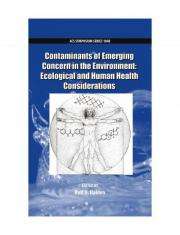This is the book cover for ACS publication "Contaminants of Emerging Concern in the Environment: Ecological and Human Health Considerations." Credit: American Chemical Society
Chemicals pervade our lives. While the benefits to society from the development of these chemicals have been impressive, enabling safer, more efficient and more convenient consumer products and life-saving pharmaceuticals, many chemicals also have a dark side. Today, a growing awareness of the risks posed to humans and the environment from harmful chemicals has stimulated intensive investigations into their lifecycle and the unintended consequence of their use.
The topic is vast, though much of what is known about many potentially harmful chemicals has been assembled in a new book, appearing this week: Contaminants of Emerging Concern in the Environment: Ecological and Health Considerations, published by the American Chemical Society.
Rolf Halden, a biologist and engineer at the Biodesign Institute at Arizona State University edited the ambitious volume, which provides a sourcebook to researchers in the field as well as to policymakers grappling with the daunting challenges facing chemically reliant societies.
"The book consists of 27 chapters, covering everything from the sources of environmental pollution with pharmaceuticals and personal care products and other emerging contaminants, to exposure, environmental bioaccumulation and health effects on aquatic and terrestrial biota, as well as on humans," Halden says.
Chemical contaminants have begun to undermine the foundations of the planet's ecosystem— the air, water, soil and food supply upon which all life depends. Robert S. Lawrence, director of the Center for a Livable Future at the John Hopkins Bloomberg School of Public Health, writes the following, in his preface to the book: "On the horizon looms a perfect storm. The production of new chemicals stretches and often exceeds the capacity of current safety monitoring and risk assessment technologies."
As Halden explains, the book grew out of an extensive symposium held in 2009, in Washington, D.C. Entitled Emerging Contaminants, Pharmaceuticals and Personal Care Products (PPCPs), and Organohalogens in Wastewater and Municipal Biosolids, the symposium was sponsored by the American Chemical Society, the largest scientific society in the world. The resulting text relies in part on research presented at the ACS meeting, examining the risks associated with a broad range of persistent organic pollutants, including pharmaceutical and personal care products, natural and synthetic hormones, perfluorinated compounds and other organohalogens, (chemicals containing one or more carbon-halogen bonds).
"As we began to prepare the book," Halden explains, "the scope increased from just pharmaceuticals and personal care products to other chemicals, for example flame retardants, compounds used in electronics and in sofas for preventing house fires, and so forth. The book closely examines chemicals that are now on the radar screen for having potential risks—these we call contaminants of emerging concern or CECs."
Following the American Chemical Society symposium, presenters were asked to write a chapter for the forthcoming book. Subsequently, a great deal of additional material was requested from scientific authorities in government and academia worldwide, with each chapter in the 600-page text receiving careful peer review. "We compile a lot of information on chemicals that had previously been discussed and also look at chemicals that have not received much scrutiny," Halden says, adding that the comprehensive treatise will likely remain relevant for many years to come.
The book is organized into three major sections: 1) environmental sources, occurrences and fates of CECs; 2) exotoxicological and human health risks of CECs; and 3) modeling tools, research needs and policy options for managing CECs.
In the years leading up to the ACS symposium, media attention had been gathering around the issue of chemicals of concern, including pharmaceuticals and personal care products, natural and synthetic hormones, various agricultural pesticides, perfluorinated compounds (PFCs) and other persistent organohalogens. In 2002, the United States Geological Survey released a study that used a battery of new scientific techniques to pinpoint 95 wastewater-derived compounds in 139 of the nation's streams.
In 2008, an investigation commissioned by the Associated Press identified traces of one or more pharmaceuticals in the water supply of over 41 million U.S. citizens and in 2009, alarming reports of chemically affected "intersex fish" were reported to Congress and also made headlines nationally. It has become increasingly clear over the past decade that surface, ground and drinking-water supplies have already been significantly contaminated by a host of chemicals, the full effects of which remain largely unknown.
While chemicals showing acute toxicity to humans and the environment have been given more attention and been subject to stiffer regulation, a vast array of chemicals once believed to be safe are getting a second look, as new genomic and epigenomic studies shed light on the supreme sensitivity of cellular structures and metabolic pathways to CEC impacts, even at low dosages. Many such chemicals, described in detail in the new text, were the focus of a special workshop sponsored by the National Institute of Environmental Health Sciences (NIEHS), held in Tucson, Arizona in 2009.
As Halden notes in his preface to the book, "emerging contaminants in the environment is a topic that is here to stay." The new work should encourage further research and where appropriate, regulatory action mandating the safe use of chemicals—a matter of grave importance to public health.
More information: The full text of Contaminants of Emerging Concern in the Environment: Ecological and Human Health Considerations is also available online at: pubs.acs.org/isbn/9780841224964
Provided by Arizona State University


















